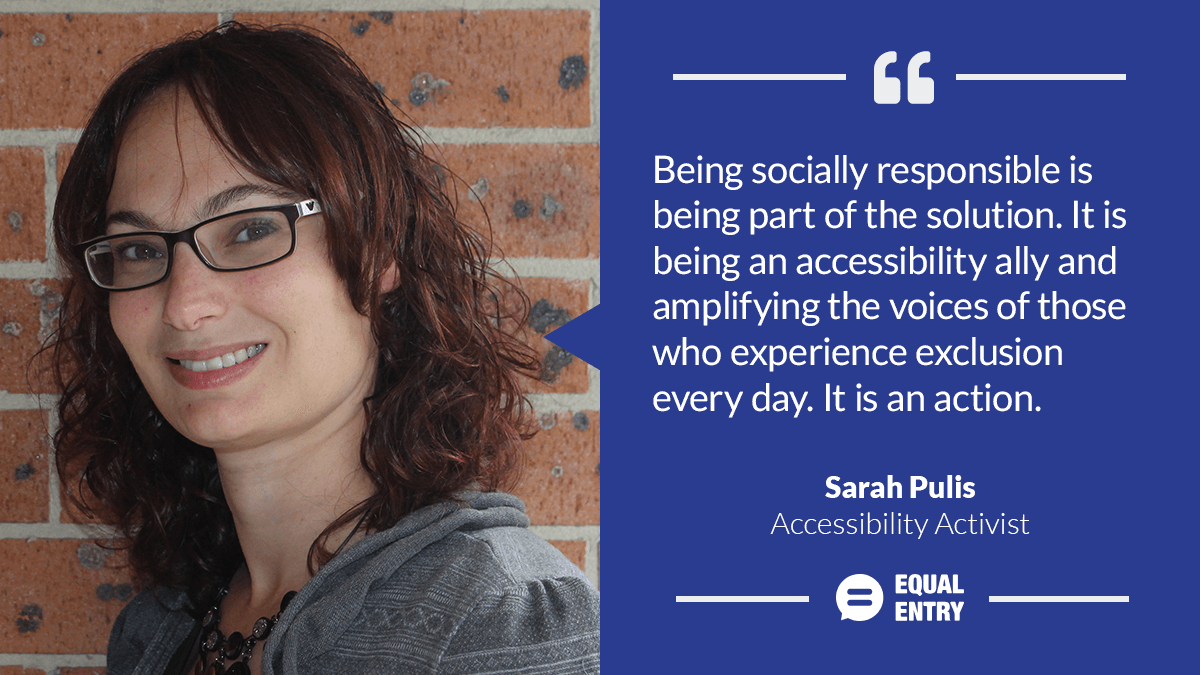Summary

Sarah Pulis has worked in digital accessibility and inclusive design for over 10 years. She co-founded Intopia over 4 years ago which is now the largest digital accessibility consultancy in Australia and New Zealand.
How did you get your start in accessibility?
My accessibility “ah-ha” moment happened in 2003. I was at a conference, and I saw a presentation that showed that a real estate website couldn’t be used by a screen reader user. To search for a property, you had to first select your state from an image map of Australia. Of course, the map was completely inaccessible to screen reader users. I still remember that moment as if it was yesterday.
I kept an interest in accessibility while studying and working for the next 8 years. It was in 2010 that I had the opportunity to move into accessibility full-time, and I’ve never looked back.
I realize that who I am today has been shaped by the different organizations and the different people that I’ve worked with. The first organization I worked with, Media Access Australia, was a not-for-profit that advocated for increased access to different types of media, including digital. This gave me an understanding and appreciation of the importance of equal access. I built my technical knowledge of digital accessibility as well. At the time though, I realized a lot of my knowledge was theoretical.
In my second accessibility job with Stamford Interactive and then PwC Australia, I was a consultant within a UX team that had a strong focus on accessibility. This allowed me to broaden my thinking about accessibility and understand the importance of user experience design in creating accessible products. In helping different organizations with accessibility, I also began to appreciate some of the business challenges organizations face as they begin to implement accessibility.
In 2016, you co-founded Intopia with Adem Cifcioglu and Stewart Hay with an emphasis on and commitment to social responsibility. What does social responsibility mean to you and how does it relate to the business of accessibility?
In February 2016, Adem Cifcioglu, Stewart Hay and I started Intopia. I still work directly with organizations, drawing on and honing the knowledge and experience I have gathered from working with so many amazing people in my past roles. And now I’m learning from my own team who bring their experience and their knowledge into the collective that is Intopia.

To me, social responsibility really boils down to making a positive difference. You would think a question like this would be easy for me to answer, and yet here I sit, struggling to put pen to paper. I think the reason is that social responsibility is not something I stop and think about, it is just something I do. It is an integral part of who I am and what Intopia is and does.
The UN has stated that access to technology is a fundamental human right. We as individuals and as a society rely on technology for many of our everyday activities. Each time we make an active decision to exclude someone, to build something that is inaccessible, we are denying someone the ability to participate, to be independent, to contribute. We are being socially irresponsible.
Being socially responsible is being part of the solution. It is raising awareness and educating people about accessibility and inclusion. It is helping organizations take that next step to be more inclusive. It is being an accessibility ally and amplifying the voices of those who experience exclusion every day. It is an action.
What is an accessibility barrier you would like to see solved?
I would like to see a fundamental shift from accessibility as a minimum-effort approach to accessibility that is driven by inclusive design. My definition of the minimum-effort approach is when organizations do the bare minimum to improve the accessibility of their products. This is often focused on meeting accessibility standards such as WCAG.
Anyone who knows me knows I’m a fan of WCAG (and EN 301 549 for that matter). This is not about the standards themselves. It’s about the perception that if you meet the standard, your product can be used by people with disability. Nothing more to do, you’re accessible. Tick. Done. The truth is often very different. A system that hasn’t been designed to be accessible, which is often repaired to meet accessibility standards after it has been built, can still mean a poor experience for users. I’ve seen users still have difficulty completing key tasks on a site that meets (or nearly meets) accessibility standards.
Now, don’t get me wrong, I’m also a pragmatist about accessibility – organizations have to start somewhere. And if there are known accessibility barriers that can be identified by a review against accessibility standards, then we should take full advantage of WCAG as a tool. But it is one tool in our toolkit towards an accessible experience, not the only tool.
So why do I want to see a shift to inclusive design? At the heart of inclusive design is the user. Accessibility barriers come from a lack of understanding of all our users and a lack of consultation with those users. That is the barrier that I want to see removed.